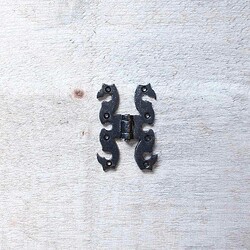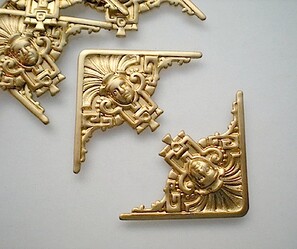Your effort into transfering the images (never mind the origin) was really worth the effort. Supreme!
Good question, and one that I admit I’d never thought about! Screen #2 weighs 5 pounds, or 1.6 pounds per panel. BTW, each panel measures 14” x 10”.
This turned out amazing!
Should we apply this to every technology that threatens the gainful application of human expertise? What makes this technology different?
What I hear most often is that this is different because it threatens artists. The same sort of threat arose with the birth of photography, which was villainized by artists at the time, and MANY artists lost work; it was a sea change. I can even perfectly replicate an artist’s work with photography, yet our society has addressed this threat while embracing the change.
We as a society have rarely succeeded at putting the genie back in the bottle.
Ask the stevedores how much difference it makes to be mad about new technology.
Oh wait, you can’t because there aren’t any.
Are we still mad at the printing press and then printers and by extension laser printers(engravers) for taking all the scribes copying jobs and wood carvings and stone etchings and all the various inking jobs we can do via technology? Seems an odd take to have as a tech enthusiast. Or all the film cutters, stop motion experts, job loss of farriers and general blacksmiths, the dockworker? Ought we to roll ourselves back to the Stone Age to make sure no human potential skill is left by the wayside?
There are certainly issues to be had with how these systems have been fed resources, but in the end they are just tools that are more advanced at making a thing. We don’t seem to take issue when a program daws a perfect circle for us, or rearranges a layout, or any number of automated processes.
Not sure how the word “simple” got in there, must be a typo.
In any case, what an amazing creation!
And thank you for the writeup. We have a friend who’s moving and recently mentioned they had gotten into GMing. I could never begin to produce such artistry, but maybe I can manage a folding screen with something engraved on it as a housewarming present.
Thank you!
That sounds like a great idea! Here are a few items from my inspirations file, roads I didn’t go down, in case they spark anything:
Find interesting hardware
Hinges with character:
Or search Etsy or elsewhere for metal corner embellishment:
Atmospheric
Gate and upholstery hardware on stained wood:
Acrylics
Just hinging two or three of these (or other interesting acrylics), maybe backed with opaque white, could make a stunning screen. Acrylic hinges exist too.
Have fun with it!
It is a paradigm shift, as jobs are lost to new technology, new ones (usually of greater skill and economic value) are created to sustain the new one. The challenge is to re-train the workforce to the new work demand.
As a society we tend to resist change because it upends the status quo, but as a quote attributed to Heraclitus says “The only thing permanent is change.”
As hard as it may seem, the sooner we embrace responsible change, the faster we will adapt.
On the other side, there will always be people with enough money that they will sustain the demand of old skills and technology. I know people who still comission hand painted portraits, tailored clothes and shoes, and hand built and finished furniture, and the artisans who cater to their whims make a ton of money.
Those of us old enough to remember DEC (Digital Equipment Corp) remember its president Ken Olsen who said “I can’t see any reason that anyone would want a computer of their own” when discussing the potential of a downsized PDP8 as a personal computer. Not only did DEC miss the PC revolution but failed to anticipate the time when virtually everyone has a computer in their pocket.
I think both inventions created a few new jobs while also displacing a few less COBOL and BAL programmers ![]()
As folks have mentioned, Photography made its impact on illustration (and AI did on photography) yet in each case they became a form of art in their own right.
My own thoughts flow to the “new tool” description as our lasers themselves short-circuit hours of difficult work with a scroll saw, and thus “cheat” when competing against the use of saw work. I used to do that sort of work with jewelers’ saws and silver at the dawn of CNC, and they were far less expensive, and I saw them as less worth.
I use the Glowforge Magic Canvas, much as the laser, to get past parts of excessive labor, but no design is used without varying amounts of finish work, that hundreds of tries might yield a very few usable results. Over the years I have seen many “artists” that the tools design the work and they call it their “style” but if you toss their work into a pile of their work you would never be able to tell from the rest of the pile. I have over 100 pieces in the catalog and you can see my style to pick out any that are mine (AI-sourced or not) and not confuse one piece with the group, or anything else created with Magic Canvas with any of my work.
Beautiful work and thank you for the extensive write up!
@evansd2 Wondering if you had a chance to check out your order? Their two reviews don’t have comments, so thought I’d check with you first.
I got them sheets, and they look good, but I havent had a chance to cut it yet.
I did a flashlight test and it seemed reasonably clear, some small internal knots and a mysterious dark band that I assume is some sort of change in the internal wood layer, but no voids.
I may be able to try tonight. Currently soldering something ![]()
Thank you! Solder away! ![]()



